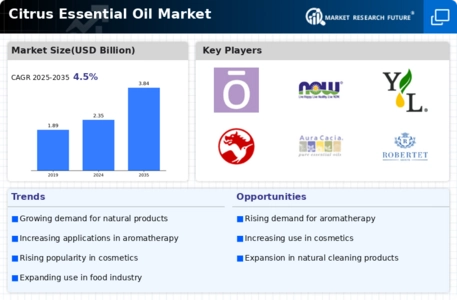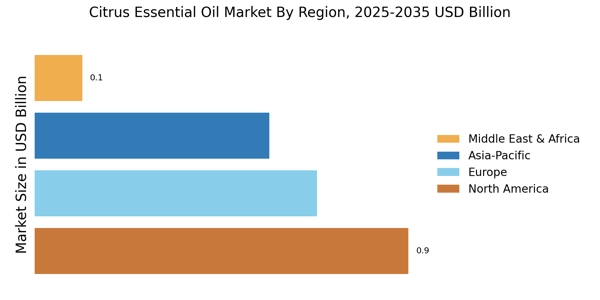Emergence of E-commerce Platforms
The emergence of e-commerce platforms is transforming the retail landscape for the Citrus Essential Oil Market. With the rise of online shopping, consumers now have greater access to a diverse range of citrus essential oils, often at competitive prices. E-commerce sales in the essential oils sector have been growing rapidly, with estimates suggesting a growth rate of around 10% annually. This shift allows consumers to explore various brands and products from the comfort of their homes, thereby increasing overall market reach. Additionally, online platforms often provide detailed product information and customer reviews, which can influence purchasing decisions. As a result, the Citrus Essential Oil Market is likely to benefit from this trend, as more consumers turn to online channels for their essential oil needs.
Growing Awareness of Aromatherapy
The increasing awareness of aromatherapy and its benefits appears to be a pivotal driver for the Citrus Essential Oil Market. Consumers are becoming more informed about the therapeutic properties of essential oils, particularly citrus varieties like lemon and orange. This trend is reflected in the rising sales of aromatherapy products, which have shown a compound annual growth rate of approximately 8% in recent years. As individuals seek natural remedies for stress relief and overall well-being, the demand for citrus essential oils is likely to surge. Furthermore, the integration of these oils into wellness practices, such as massage and meditation, suggests a broader acceptance of holistic health approaches. Consequently, the Citrus Essential Oil Market is poised for growth as more consumers incorporate these oils into their daily routines.
Expansion of the Personal Care Sector
The expansion of the personal care sector is another significant driver influencing the Citrus Essential Oil Market. Citrus essential oils, known for their refreshing scents and skin benefits, are increasingly being incorporated into a variety of personal care products, including lotions, shampoos, and soaps. The personal care market has experienced a notable increase, with projections indicating a growth rate of around 5% annually. This trend is largely attributed to consumer preferences shifting towards natural and organic ingredients, which are perceived as safer and more effective. As brands strive to meet these demands, the inclusion of citrus essential oils in formulations is likely to enhance product appeal. Thus, the Citrus Essential Oil Market stands to benefit from this ongoing trend, as manufacturers seek to innovate and differentiate their offerings.
Rising Popularity of Clean Label Products
The rising popularity of clean label products is significantly impacting the Citrus Essential Oil Market. Consumers are increasingly scrutinizing ingredient lists and favoring products that are transparent about their contents. This trend has led to a surge in demand for natural ingredients, including citrus essential oils, which are often marketed as free from synthetic additives. Market data indicates that the clean label segment is expected to grow at a rate of 7% per year, reflecting a shift in consumer preferences towards authenticity and simplicity. As manufacturers respond to this demand by reformulating products to include citrus essential oils, the market for these oils is likely to expand. This shift not only aligns with consumer values but also enhances the overall appeal of products in the Citrus Essential Oil Market.
Increased Use in Food and Beverage Applications
The increased use of citrus essential oils in food and beverage applications is emerging as a key driver for the Citrus Essential Oil Market. These oils are valued for their flavor-enhancing properties and are being utilized in a variety of products, from beverages to baked goods. The food and beverage sector has shown a consistent growth trajectory, with a projected increase of approximately 4% annually. This trend is fueled by consumer demand for natural flavors and healthier alternatives to artificial additives. As manufacturers seek to innovate and create unique flavor profiles, the incorporation of citrus essential oils is likely to become more prevalent. Consequently, this trend is expected to bolster the Citrus Essential Oil Market, as more companies recognize the potential of these oils in enhancing product offerings.


















Leave a Comment